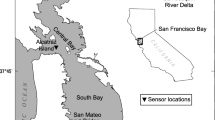Abstract
A simple method has been proposed for estimating the deposition and mixing rates of river-borne suspended matter and mapping the deposition intensity in near-estuary sea areas. The method involves the joint analysis of data on the total suspended solids (TSS) concentration and salinity. The relative content of river runoff in seawater is determined from the salinity value. If the suspended matter is subject to deposition, its concentration would be fully determined by the relative content of river water in the seawater and could be calculated based on salinity. However, the factual TSS concentration is usually lower than that estimated from salinity, because of deposition. Hence, the amount of TSS deposited from a specific water parcel can be obtained as the difference between the concentration prescribed by the linear mixing of river and seawater masses and the factual concentration. This scheme has been implemented using high-resolution data collected in field campaigns in the Black Sea near the Mzymta River mouth. The TSS concentration was obtained using ultraviolet fluorescence lidar, and salinity was measured by a pump-through CTD system.
Similar content being viewed by others
References
N. A. Aibulatov, P. O. Zavialov, and V. V. Pelevin, “Peculiarities of hydrophysical self-purification of Russian coastal zone of the Black Sea near the river estuaries,” Geoekol., Inzh. Geol., Gidrogeol., Geokriol., No. 4, 301–310 (2008).
P. O. Zavialov, A. S. Izhitskiy, A. A. Osadchiev, V. V. Pelevin, and A. B. Grabovskiy, “The structure of thermohaline and bio-optical fields in the surface layer of the Kara Sea in September 2011,” Oceanology (Engl. Transl.) 55 (4), 461–471 (2015).
P. O. Zavialov, P. N. Makkaveev, B. V. Konovalov, A. A. Osadchiev, P. V. Khlebopashev, V. V. Pelevin, A. B. Grabovskiy, A. S. Izhitskiy, I. V. Goncharenko, D. M. Soloviev, and A. A. Polukhin, “Hydrophysical and hydrochemical characteristics of the sea areas adjacent to the estuaries of small rivers of the Russian coast of the Black Sea,” Oceanology (Engl. Transl.) 54 (3), 265–280 (2014).
A. P. Lisitzin, Ocean Sedimentation (Nauka, Moscow, 1977) [in Russian].
S. C. Palmer, V. V. Pelevin, I. V. Goncharenko, et al., “Ultraviolet fluorescence LiDAR (UFL) as a measurement tool for water quality parameters in turbid lake conditions,” Remote Sens. 5 (9), 4405–4422 (2013).
S. D. Smith, “Wind stress and heat flux over the ocean in gale force winds,” J. Phys. Oceanogr. 10 (5), 709–726 (1980).
Author information
Authors and Affiliations
Corresponding author
Additional information
Original Russian Text © P.O. Zavialov, E.S. Barbanova, V.V. Pelevin, A.A. Osadchiev, 2015, published in Okeanologiya, 2015, Vol. 55, No. 6, pp. 922–927.
Rights and permissions
About this article
Cite this article
Zavialov, P.O., Barbanova, E.S., Pelevin, V.V. et al. Estimating the deposition of river-borne suspended matter from the joint analysis of suspension concentration and salinity. Oceanology 55, 832–836 (2015). https://doi.org/10.1134/S0001437015060211
Received:
Accepted:
Published:
Issue Date:
DOI: https://doi.org/10.1134/S0001437015060211




